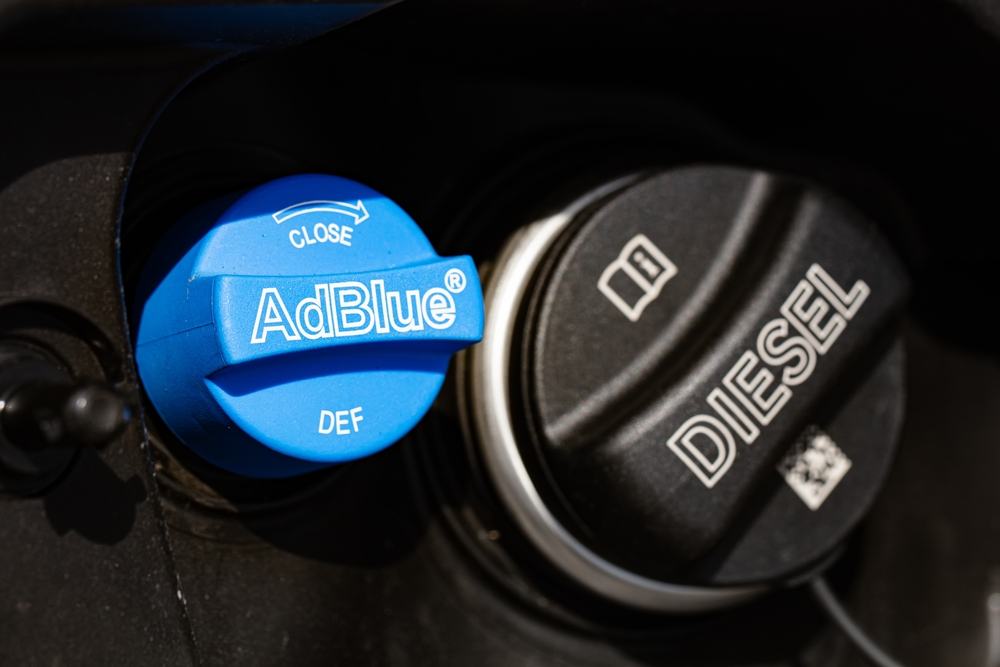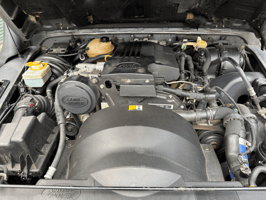The Defender might be renowned for its rugged durability and its off-road capabilities, but even...
AdBlue is an essential element of many modern diesel vehicles, helping to reduce harmful emissions and keep your Defender running cleanly whilst complying with environmental regulations. However, like any system, it isn’t without its problems. AdBlue-related faults can cause warning lights to turn on, reduce the engine’s performance, and even stop the vehicle from starting altogether. In this article we’ll take a look at some of the most common AdBlue issues faced by Defender owners, and how you can sort them out.
AdBlue is a clear, non-toxic fluid made up of 32.5% high-purity urea and 67.5% deionised water. It’s used in diesel vehicles that are equipped with Selective Catalytic Reduction (SCR) technology, which is a system designed to reduce harmful nitrogen oxide (NOx) emissions produced by diesel engines. When AdBlue is injected from its tank into the exhaust system it reacts with the NOx gases in the catalytic converter and converts them into harmless nitrogen and water vapour, which is then safely released into the atmosphere.
.jpg?width=1000&height=563&name=shutterstock_2475836979%20(1).jpg)
Clogging and crystallisation
One of the most frequent problems found with AdBlue systems is clogging or crystallisation, as AdBlue can leave behind white, chalky deposits if it dries out. This usually happens around the injectors, filler cap or inside the lines and tank. Over time, these crystals can cause blockages, disrupting the flow of AdBlue and affecting emissions control.
How to sort this:
You can look at the injector and pipework for any signs of crystal build-up. Cleaning these with warm water can dissolve minor deposits, but in more severe cases the affected parts may need to be replaced. Regularly using the vehicle and avoiding long periods of inactivity can help prevent any crystallisation occurring.
Contamination
AdBlue is highly sensitive to contaminants such as fuel, oil, dirt and even tap water and any contamination may trigger dashboard warnings. Also, using anything other than high-grade AdBlue could damage the SCR system and lead to the need for repairs - which could be costly.
How to sort this:
Be sure to drain and flush the AdBlue tank completely if any contamination is suspected, and refill it with fresh, certified AdBlue. Make sure only clean, sealed containers and designated AdBlue pumps are used during your refills, and avoid using makeshift funnels or equipment that could introduce debris into the system.

Freezing in cold weather
AdBlue can freeze at temperatures below -10°C. While most modern Defenders are equipped with heated tanks and lines to manage this, extremely cold conditions or system malfunctions can still lead to the AdBlue freezing.
How to sort this:
If the AdBlue has frozen, you may need to wait for the ambient temperature to rise or move the vehicle to a warmer location. If the heater within the system is not functioning, it may require diagnostic testing and a possible replacement. It’s wise to check for any stored fault codes using a diagnostic tool.
Incorrect levels used
Having too little AdBlue can cause the vehicle to go into limp mode, or the Defender could start to display other warning messages. Ultimately it may prevent the car from starting or continuing to run, as it reduces the engine’s power to limit its emissions.
How to sort this:
Always monitor your AdBlue levels using the vehicle’s onboard system and top it up when required. Avoid filling beyond the maximum line, however. If a low level has been reached, a reset via diagnostics may be needed after the correct amount has been added. Regularly topping up with AdBlue before it gets too low is a good preventative measure to anything going wrong in this area. This is a key point, however - don’t put it in the diesel tank, just the AdBlue tank! Diesel and AdBlue most definitely do not mix…

Pump and sensor failures
Like many modern vehicle systems, the AdBlue system relies on various sensors and a small pump to function properly. These components can fail due to age, contamination, electrical issues, or perhaps other mechanical faults. Common symptoms include persistent AdBlue warnings on the dash, incorrect level readings, or the car ultimately failing to start.
How to sort this:
A full diagnostic scan is usually the first step. This will pinpoint whether a pump, level sensor or temperature sensor has failed. Replacing these parts can be a fiddly job, especially as many components are located in or around the AdBlue tank so it’s often best carried out by a mechanic unless you’re confident with vehicle maintenance.
AdBlue is a pretty clever and eco-friendly system, but it does need a little care and attention! If you take the time to understand how these common issues can arise, and how to identify and repair them, you’ll hopefully avoid any unnecessary stress and expense, and you’ll keep your Defender performing at its best.
Remember, though - if you’re unsure or uncomfortable with any AdBlue-related repair, don’t hesitate to consult a mechanic or Land Rover specialist.






